The AMD 3rd Gen Ryzen Deep Dive Review: 3700X and 3900X Raising The Bar
by Andrei Frumusanu & Gavin Bonshor on July 7, 2019 9:00 AM EST** = Old results marked were performed with the original BIOS & boost behaviour as published on 7/7.
Benchmarking Performance: CPU Rendering Tests
Rendering is often a key target for processor workloads, lending itself to a professional environment. It comes in different formats as well, from 3D rendering through rasterization, such as games, or by ray tracing, and invokes the ability of the software to manage meshes, textures, collisions, aliasing, physics (in animations), and discarding unnecessary work. Most renderers offer CPU code paths, while a few use GPUs and select environments use FPGAs or dedicated ASICs. For big studios however, CPUs are still the hardware of choice.
All of our benchmark results can also be found in our benchmark engine, Bench.
Corona 1.3: Performance Render
An advanced performance based renderer for software such as 3ds Max and Cinema 4D, the Corona benchmark renders a generated scene as a standard under its 1.3 software version. Normally the GUI implementation of the benchmark shows the scene being built, and allows the user to upload the result as a ‘time to complete’.
We got in contact with the developer who gave us a command line version of the benchmark that does a direct output of results. Rather than reporting time, we report the average number of rays per second across six runs, as the performance scaling of a result per unit time is typically visually easier to understand.
The Corona benchmark website can be found at https://corona-renderer.com/benchmark
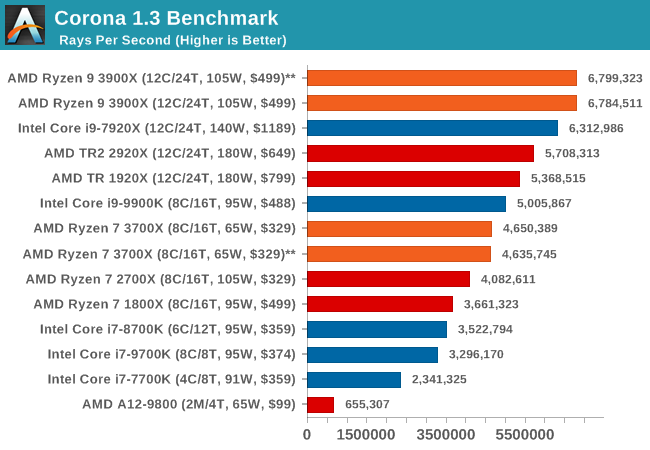
LuxMark v3.1: LuxRender via Different Code Paths
As stated at the top, there are many different ways to process rendering data: CPU, GPU, Accelerator, and others. On top of that, there are many frameworks and APIs in which to program, depending on how the software will be used. LuxMark, a benchmark developed using the LuxRender engine, offers several different scenes and APIs.

Taken from the Linux Version of LuxMark
In our test, we run the simple ‘Ball’ scene on both the C++ and OpenCL code paths, but in CPU mode. This scene starts with a rough render and slowly improves the quality over two minutes, giving a final result in what is essentially an average ‘kilorays per second’.

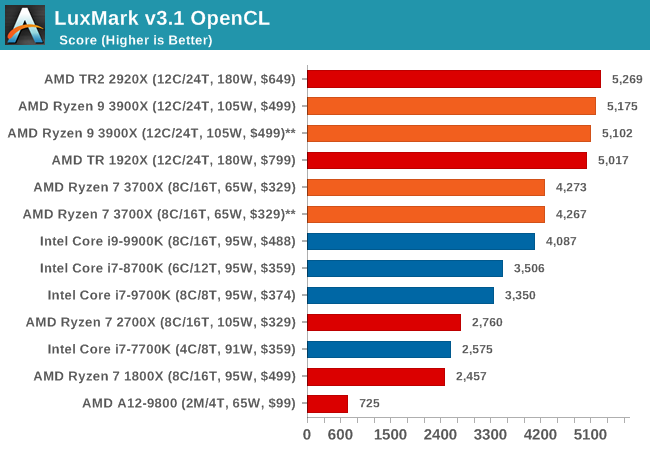
POV-Ray 3.7.1: Ray Tracing
The Persistence of Vision ray tracing engine is another well-known benchmarking tool, which was in a state of relative hibernation until AMD released its Zen processors, to which suddenly both Intel and AMD were submitting code to the main branch of the open source project. For our test, we use the built-in benchmark for all-cores, called from the command line.
POV-Ray can be downloaded from http://www.povray.org/
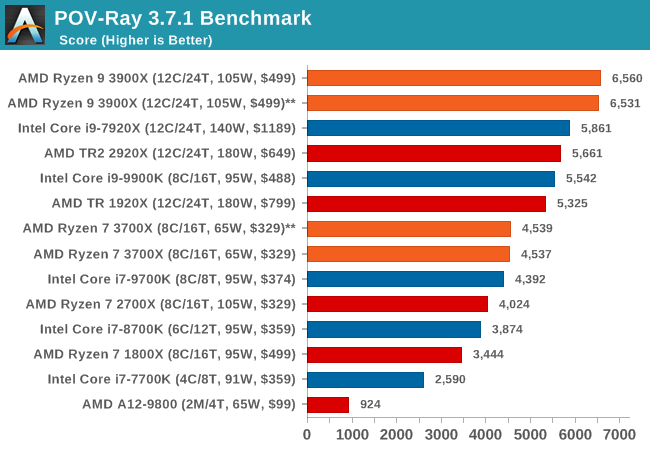
Cinebench R15
The latest version of CineBench has also become one of those 'used everywhere' benchmarks, particularly as an indicator of single thread performance. High IPC and high frequency gives performance in ST, whereas having good scaling and many cores is where the MT test wins out.
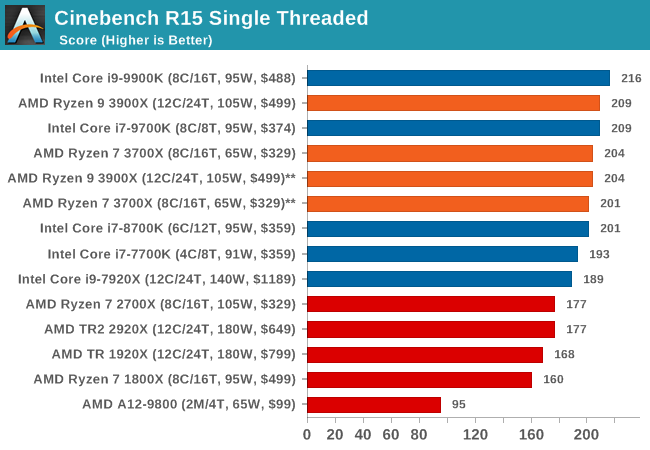
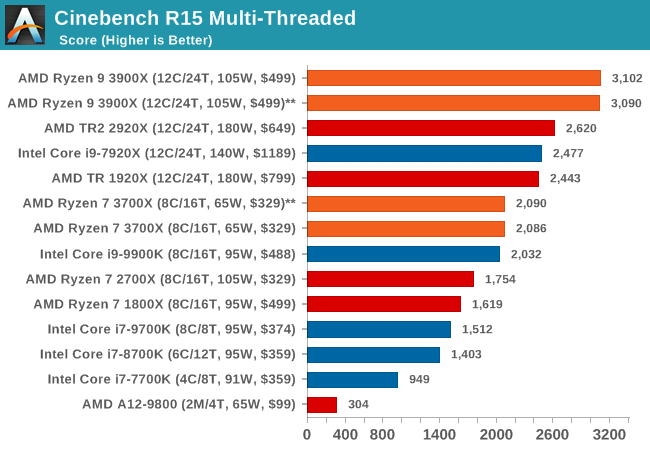











447 Comments
View All Comments
catavalon21 - Sunday, July 7, 2019 - link
The 2600K had legs as good as any modern CPU, but I don't agree that "most" people are still using a CPU 6 to 8 years old.yeeeeman - Monday, July 8, 2019 - link
Most people are still on Sandy bridge, ivy bridge or haswell. All of these are nothing compared to what 3900x offers and also 3700x. That is the main idea here. There is no point in buying 9900k just to pay a lot more for 5% fps increase at 1080p. That is nitpicking at its best. You are much better off with a 3900x. You get 2950x mt performance, you get more than enough gaming performance and you get lower power consumption than 9900k.Namisecond - Sunday, July 7, 2019 - link
Intel had better marketing, better suppliers, better chipsets, better networking, etc. AMD having a better CPU just doesn't seem to be enough.just4U - Sunday, July 7, 2019 - link
Better chipsets? Amd just released the x570 what does the 390 chipset offer that the x570 does not?Meteor2 - Sunday, July 14, 2019 - link
"He stated in article it took amd 15 YEARS to get this good CPU finally out and sounded like he was impressed by that?" No. That's why it was awarded a Silver.Korguz - Sunday, July 7, 2019 - link
not according to Maxiking, catavalon21... starting to sound like Maxiking, is another HStewart .....shabby - Wednesday, July 10, 2019 - link
Where is Hstewart anyway? LolOliseo - Sunday, July 7, 2019 - link
"But not when the raw performance is tconsidered. It is a hypothetical scenario"How can you take someone seriously when they say this on an article that provides the evidence they claim is "hypothetical".
You simply can't. Either they think you're stupid, or they don't know they are.
It's one or the other. What do you reckon it is.
Andrei Frumusanu - Sunday, July 7, 2019 - link
Please don't take our current numbers as any sign of overclockability - we didn't have enough time for it and motherboard firmwares are still getting updated.Maxiking - Sunday, July 7, 2019 - link
Your numbers on par with the rest of the world, so you maxed out those chips.